Classes | |
| struct | BVHSaveParam |
| class | CAppCallBack |
| class | CBaseFrameTool |
| class | CContrastDLG |
| class | CDx2DView |
| class | CDx3DDirectView |
| class | CDxBaseView |
| class | CDxDirectView |
| class | CDxGraphDoc |
| class | CDxMGRView |
| class | CDxSRenderView |
| class | CDxVScrollView |
| class | CDxVTXBaseView |
| class | CExDocument |
| class | CExFrame |
| class | CExSMPLDisp |
| class | CExTextFrame |
| class | CExTextView |
| class | CExToolBar |
| class | CExView |
| class | CInputFloatNumDLG |
| class | CInputMultiFloatNumDLG |
| class | CInputNumDLG |
| class | CLogWndDoc |
| class | CLogWndFrame |
| class | CLogWndView |
| class | CMessageBoxDLG |
| class | CNiBVHTool |
| class | CNiFileTool |
| class | CNiJoints |
| class | CNiJTextTool |
| class | CNiVMDTool |
| class | CProgressBarDLG |
| class | CProgressTextDLG |
| class | CReadFilesDLG |
| class | CRwGRDoc |
| class | CSetHeaderDLG |
| class | CvThumbNailDoc |
| class | CvThumbNailFrame |
| class | CWinAudioStream |
| class | CWinAudioTool |
| class | CWinMediaBuffer |
| class | CWinSharedMem |
| class | CWriteFilesDLG |
| class | DLLModule |
| class | DLLModuleTBL |
| class | EventHandler |
Typedefs | |
| typedef char *(* | FUNC_STRING) (int) |
| typedef std::stack< CWinMediaBuffer * > | MediaBufferStack |
| typedef std::queue< CWinMediaBuffer * > | MediaBufferQueue |
Enumerations | |
| enum | SENDKEY_Action { SENDKEY_TapAction , SENDKEY_DownAction , SENDKEY_UpAction } |
| enum | NiSDK_Lib { NiSDK_Default , NiSDK_None , NiSDK_Kinect , NiSDK_OpenNI , NiSDK_OpenNI2 } |
Functions | |
| BOOL | InputNumDLG (LPCTSTR title, int *val) |
| BOOL | InputFloatNumDLG (LPCTSTR title, double *val) |
| BOOL | InputMultiFloatNumDLG (LPCTSTR t0, double *v0, LPCTSTR t1=NULL, double *v1=NULL, LPCTSTR t2=NULL, double *v2=NULL, LPCTSTR t3=NULL, double *v3=NULL, LPCTSTR t4=NULL, double *v4=NULL, LPCTSTR t5=NULL, double *v5=NULL) |
| CMessageBoxDLG * | MessageBoxDLG (int ttl, int msg, CWnd *wnd=NULL) |
| CMessageBoxDLG * | MessageBoxDLG (LPCTSTR ttl, int msg, CWnd *wnd=NULL) |
| CMessageBoxDLG * | MessageBoxDLG (int ttl, LPCTSTR msg, CWnd *wnd=NULL) |
| CMessageBoxDLG * | MessageBoxDLG (LPCTSTR ttl, LPCTSTR msg, CWnd *wnd=NULL) |
| int | MessageBoxDLG (int ttl, int msg, UINT type, CWnd *wnd=NULL) |
| int | MessageBoxDLG (LPCTSTR ttl, int msg, UINT type, CWnd *wnd=NULL) |
| int | MessageBoxDLG (int ttl, LPCTSTR msg, UINT type, CWnd *wnd=NULL) |
| int | MessageBoxDLG (LPCTSTR ttl, LPCTSTR msg, UINT type, CWnd *wnd=NULL) |
| HRESULT | ResetDx9Device (LPDIRECT3DDEVICE9, D3DPRESENT_PARAMETERS *, CDxBaseView *pviw=NULL) |
| int | ExecTemplate (CMultiDocTemplate *ptemp, ExMSGraph< sWord > *pmsGraph=NULL, ExCmnHead *pcmnHead=NULL, CExFrame *prntFrm=NULL, int vPoint=0) |
| CExFrame * | CreateDocFrmView (CMultiDocTemplate *pDocTemp, CAppCallBack *papp=NULL) |
| int | ExecDocFrmView (CExFrame *pfrm, LPCTSTR fname=NULL) |
| void | ExecDocFrmViewError (HWND hwnd, int ret) |
| BOOL | InitialDocView (CExFrame *pfrm, LPCTSTR fname) |
| bool | SetExLink (CExDocument *pdoc, CExFrame *pfrm, CExView *pview, CAppCallBack *papp) |
| CString | EasyGetOpenFileName (LPCTSTR title=NULL, HWND hWnd=NULL) |
| CString | EasyGetSaveFileName (LPCTSTR title=NULL, LPCTSTR extnt=NULL, HWND hWnd=NULL) |
| CString | EasyGetSaveFolderName (LPCTSTR folder=_T(""), LPCTSTR title=NULL, HWND hWnd=NULL) |
| int CALLBACK | EasyGetSaveFolderNameCallBack (HWND hwnd, UINT uMsg, LPARAM lParam, LPARAM lpData) |
| int | copyFileWithCounter (LPCTSTR src, LPCTSTR dst) |
| int | copyFPWithCounter (FILE *src, FILE *dst, unsigned long int sz) |
| int | writeGraphicFileWithCounter (LPCTSTR fname, MSGraph< sWord > vp, int kind, BOOL mlt=FALSE, int fn=0, int tn=0) |
| CMenu * | GetMenu_byID (CMenu *pMenu, UINT id) |
| CMenu * | GetMenu_byStringID (CMenu *pMenu, UINT id) |
| CMenu * | GetMenu_byName (CMenu *pMenu, LPCTSTR name) |
| void | RebootProgram (void) |
| BOOL | WaitPidTerm (int tm) |
| CLogWndFrame * | ExecLogWnd (CMultiDocTemplate *pDocTempl, LPCTSTR title, CAppCallBack *app) |
| BOOL | Dx9CreateInterface (CWinApp *wapp) |
| void | Dx9ReleaseInterface () |
| LPDIRECT3DDEVICE9 | Dx9CreateGraphic (LPDIRECT3D9, D3DPRESENT_PARAMETERS *, HWND) |
| LPDIRECTINPUTDEVICE8 | Dx9CreateMouse (LPDIRECTINPUT8, HWND) |
| LPDIRECTINPUTDEVICE8 | Dx9CreateKeyBoard (LPDIRECTINPUT8, HWND) |
| POINT | Dx9GetBackBuffer (LPDIRECT3DDEVICE9, LPDIRECT3DSURFACE9 *) |
| BOOL | Dx9SurfaceFromMemory (LPDIRECT3DDEVICE9, LPDIRECT3DSURFACE9 *, CmnHead) |
| BOOL | Dx9TextureFromMemory (LPDIRECT3DDEVICE9, LPDIRECT3DTEXTURE9 *, CmnHead) |
| BOOL | Dx9SurfaceFromByteMemory (LPDIRECT3DDEVICE9, LPDIRECT3DSURFACE9 *, CmnHead) |
| BOOL | Dx9SurfaceFromMemoryFile (LPDIRECT3DDEVICE9, LPDIRECT3DSURFACE9 *, CmnHead) |
| BOOL | Dx9TextureFromByteMemory (LPDIRECT3DDEVICE9, LPDIRECT3DTEXTURE9 *, CmnHead) |
| BOOL | Dx9TextureFromMemoryFile (LPDIRECT3DDEVICE9, LPDIRECT3DTEXTURE9 *, CmnHead) |
| HRESULT | Dx9DrawPrimitive (LPDIRECT3DDEVICE9, D3DPRIMITIVETYPE, UINT, UINT) |
| POINT | Dx9GetSurfaceSize (LPDIRECT3DSURFACE9 *lpsf) |
| D3DCOLOR | Dx9Word2RGBA (uWord pp) |
| D3DCOLOR | Dx9Word2ARGB (uWord pp) |
| D3DCOLOR | Dx9Word2RGB (uWord pp) |
| void | open_shm_debuger (void) |
| void | close_shm_debuger (void) |
| Buffer | tc2Buffer (TCHAR *tchar, int size=-1) |
| locale が正しくないと,日本語の変換は失敗する. ex.) setlocale(LC_CTYPE,"jpn") or setSystemLocale() | |
| Buffer | ts2Buffer (LPCTSTR str, int size=-1) |
| Buffer | String2Buffer (CString str) |
| CString | mbs2ts (char *str) |
| char * | ts2mbs (LPCTSTR str) |
| int | copy_ts2Buffer (LPCTSTR str, Buffer *buf) |
| int | cat_ts2Buffer (LPCTSTR str, Buffer *buf) |
| unsigned long int | file_size_t (LPCTSTR fn) |
| BOOL | file_exist_t (LPCTSTR fn) |
| CString | get_file_name_t (LPCTSTR str) |
| CString | make_file_path_t (LPCTSTR str) |
| CString | cut_file_extension_t (LPCTSTR str) |
| tList * | read_index_tList_file_t (LPCTSTR fn, char cc) |
| tList * | get_dir_files_t (LPCTSTR dirn) |
| tList * | get_dir_files_rcsv_t (LPCTSTR dirn) |
| CString | numbering_name_t (LPCTSTR fmt, int n) |
| CString | get_tstr_param_tList (tList *lt, char *key, LPCTSTR dflt) |
| void | setResourceLocale (void) |
| CString | getResourceLocale (void) |
| void | setSystemLocale (LPCTSTR locale=_T("")) |
| Buffer | utf8_to_sjis_byStr (CString str) |
| Buffer | utf8_to_sjis (void *ptr, size_t len) |
| Buffer | sjis_to_utf8_byStr (CString str) |
| Buffer | sjis_to_utf8 (void *ptr, size_t len) |
| CString | GetCurrentUserHomeFolder (void) |
| CString | GetDefaultUserHomeFolder (void) |
| CString | MakeWorkingFolderPath (LPCTSTR fnm, BOOL local, LPCTSTR dir=NULL, BOOL make=FALSE) |
| CString | GetProgramFolder (void) |
| char * | GetProgramFolderA (void) |
| CString | GetCurrentFolder (void) |
| void | SendWinMessage (UINT mesg, WPARAM wparam=NULL, LPARAM lparam=NULL) |
| int | MessageDLG (LPCTSTR ttl, LPCTSTR msg, UINT type, HWND hWnd) |
| void | SaveToClipboard_byStr (CString data) |
| void | SaveToClipboard (void *ptr, size_t len) |
| void | SendKeyAction (WORD key, SENDKEY_Action action) |
| void | SendKeyActionTap (WORD key) |
| void | SendKeyActionTap (WORD key1, WORD key2) |
| void | SendKeyActionTap (WORD key1, WORD key2, WORD key3) |
| void | SendKeyActionTapAlt (WORD key) |
| void | SendKeyActionTapShift (WORD key) |
| void | SendKeyActionTapCtrl (WORD key) |
| BOOL | DoSystemKeyAction (LPCTSTR com, BOOL child=FALSE) |
| TCHAR * | GetMouseCursorType (void) |
| unsigned short | GetMsecondsTimer (void) |
| unsigned short | GetMsecondsLapTimer (unsigned short pm, unsigned short *nt=NULL) |
| CString | LoadString_byID (UINT id) |
| void | WinSystem (char *command, DWORD flag, BOOL wait) |
| template<class T > | |
| void | releaseNull (T *&ptr) |
| template<class T > | |
| void | deleteNull (T *&ptr) |
| tList * | setBVHJointName (void) |
| tList * | addBVHJointName (char *fname, tList *lt) |
| int | BVHJoint2NiJointNum (tList *lt, Buffer joint_name) |
| tTree * | makeBVH_SLHierarchy (void) |
| tTree * | makeBVH_QAvHierarchy (void) |
| tTree * | makeBVH_NiHierarchy (void) |
| vector | getQAvBVHOffset (int joint) |
| std::string | NiJointName (int n) |
| int | NiJointNum (char *name) |
| std::string | NiSDK2JointName (int joint, NiSDK_Lib lib) |
| int | NiSDKMirrorJointNum (int joint, NiSDK_Lib lib) |
| int | JointName2NiSDK (char *jname, NiSDK_Lib lib) |
| int | Ni2SDKPosJointNum (int joint, NiSDK_Lib lib) |
| int | Ni2SDKRotJointNum (int joint, NiSDK_Lib lib) |
| void | NiSetKinectJointNums (void) |
| void | NiSetOpenNIJointNums (void) |
| void | NiSetOpenNI2JointNums (void) |
| NiFrameData * | makeFramesData (int frame, int joint_num, int *frame_num) |
| void | freeFramesData (NiFrameData *frmdata, int frm_num) |
| void | NiInitRBoundJointsRotation (void) |
| void | NiCorrectJointsRotation (Quaternion< double > *quat, NiSDK_Lib lib) |
| void | NiCorrectJointEuler (int joint, Quaternion< double > *quat, RBound< double > rb) |
| void | NiGetJointEuler (int joint, Quaternion< double > *quat, Vector< double > *vect) |
| void | NiSetJointEuler (int joint, Vector< double > *vect, Quaternion< double > *quat) |
| void | NiSetUserColor (int label, uByte *ptr, BOOL use_image=TRUE) |
| unsigned int | NiGetSkeletonColor (int label) |
| std::string | VMDJointName (int n) |
| int | VMDJointNum (char *name) |
| int | VMD2NiJointNum (int joint) |
Variables | |
| CSetHeaderDLG | SetHeaderDLG |
| UINT | TimerID = 1 |
| LPDIRECT3D9 | GpD3D = NULL |
| LPDIRECTINPUT8 | GpDInput = NULL |
| LPDIRECTINPUTDEVICE8 | GpDMouse = NULL |
| LPDIRECTINPUTDEVICE8 | GpDKeyBoard = NULL |
| BOOL | Dx9DividePrimitiveMode = TRUE |
| BOOL | Dx9ReverseZMode = FALSE |
| static const WORD | WinAudioToolFormat = WAVE_FORMAT_PCM |
| static const WORD | WinAudioToolChannels = 1 |
| static const DWORD | WinAudioToolSamplesPerSec = 16000 |
| static const WORD | WinAudioToolBitsPerSample = 16 |
| CWinSharedMem * | _Debug_SHM = NULL |
| //////////////////////////////////////////////////////////// | |
Detailed Description
pview->vMin 〜 pview->vMax の間で,pview->cMin, pview->cMin を変更する.
呼び出しウィンドウをレンダリングする場合は,pview->cMin, pview->cMinの値が変更される度に 呼び出しウィンドウを再描画する.
マルチスライス読み込み設定ダイアログ
CExDocument クラス
ファイルを読み込むためのテンプレートクラス.
制御用変数
BOOL hasReadData; // 読み込みデータを持っているか?
BOOL hasViewData; // 表示用データに加工済みか?
予め cmnHeadにデータがある場合は,hasReadData=TRUE にしてOnNewDocument(void)を呼び出す.
データを読み込む場合は OnOpenDocument(LPCTSTR) を呼ぶ.
OnOpenDocument(LPCTSTR) で実際にデータを読み込むためには ReadDataFile(LPCTSTR) をオーバーライドする.
この際データは msGraph, cmnHeadの両方(別々の領域)に読み込むようにすると良い.
データ加工用の関数は MakeData(void) である.これをオーバーライドして,cmnHeadを表示用データ
に加工し,CExViewに渡す.
データの書き込みは 未実装.
CExFrame クラス
CExView とCExDocument を繋ぐためのフレームテンプレートクラス. マウス制御機能(簡易版)あり. GetMousePos() (クライアント領域でのマウスの座標) デフォルトで最大化ボックスは無効である.
CExTextFrame クラス
CExTextView とCExDocument を繋ぐためのフレームテンプレートクラス. マウス制御機能(簡易版)あり. GetMousePos() (クライアント領域でのマウスの座標) デフォルトで最大化ボックスは無効である.
ウィンドウのリサイズ時,移動時のちらつき防止効果付きツールバー
MFCLib 用入出力関数
CDx2DView クラス
CDxBaseViewクラスからの継承クラス. 対応する Document の cmnHead (pDoc->cmnHead) からデータを受け取り DirectXの機能を使って 2D画像表示を行う.静止画用. cmnHead.kind==UN_KNOWN の場合は,ExDocumentクラスで DirectXの機能を 使用して,画像フォーマットの解析を行っておかなければならない. また,cmnHead.kind が既知(CT_ADAT, CT_3DX, RAS_DATA)の場合に対しては, depthが 8bitにしか対応していないので,Documentクラスで 8bit化して おく必要がある.
CDxDirectView クラス
Viewの viewDataを直接操作して 2D画像を更新するためのクラス. 16/24/32bit カラー対応. 動画用.
CDxGraphDoc クラス
CExDocumentクラスからの継承クラス.
DirectXの機能を利用して,読み込んだ画像のフォーマットを解析する.
画像データは cmnHead, msGraph メンバに格納される.ただし,画像ファイル
のフォーマットが未知の場合は,cmnHead.kind==UN_KNOWN となり,msGraphには
画像は格納されない.画像ファイルのフォーマットが未知の場合(UN_KNOWN)は,
DirectXの機能を使用して,フォーマット解析を行う(msGraphにはデータは無し).
ここで言う「画像データのフォーマットが未知」とは作者が画像フォーマットを
知らないということ.jpeg, bmp等も含む.
画像ファイルのフォーマットが既知の場合(CT_DATA, CT_3DM, RAS_DATAなど),
画像データは msGraphにもコピーされ,cmnHeadの画像データ自体は 8bit化
される.
通常は cmnHead が Viewにわたされる.
OnOpenDocument(LPCTSTR) -> ReadDataFile(LPCTSTR);
-> MakeViewData(void);
CDxMGRView クラス
CDxBaseViewクラスからの継承クラス.マルチ画像表示.16/24/32bit カラー対応. 対応する Document の cmnHead (pDoc->cmnHead) からデータ(3Dデータ可)を受け取り DirectXの機能を使って 2D表示を行う.対直スクロールバー付き. 現在サポートしているカラー処理は Planeモード (Z方向をRGBの各色に割り当てるモード)のみ
CDxSRenderView クラス (サーフェイスレンダリング)
CDxVTXBaseViewクラスからの継承クラス
対応する Document の msGraph (pDoc->msGraph) からデータを受け取り
(cmnHeadではないので注意),(簡易)サーフェイスレンダリングを行い,
DirectXの機能を使って 3D表示する.
3D表示する場合の色は,ボクセルの輝度値(16bit)に対して,ARGB16(各4bit)
と解釈する.輝度値(16bit)の設定には
uWord ARGB2Word(uWord a, uWord r, uWord g, uWord b) (要 #include "Gdata.h")
uWord RGBA2Word(uWord r, uWord g, uWord b, uWord a) (要 #include "Gdata.h")
uWord RGB2Word (uWord r, uWord g, uWord b) (要 #include "Gdata.h")
を使用すると良い.因みに逆の関数は
D3DCOLOR Dx9Word2RGBA(uWord pp) (要 #include "Dx9.h")
D3DCOLOR Dx9Word2ARGB(uWord pp) (要 #include "Dx9.h")
D3DCOLOR Dx9Word2RGB (uWord pp) (要 #include "Dx9.h")
CDxVScrollView クラス
対応する Document の cmnHead (pDoc->cmnHead) からデータを受け取り
縦スクロール付き(画像の伸張なし)の画像を表示する.
DirectXの機能を使用する.
cmnHead.zsize にクライアント領域の初期サイズ(Yサイズ)が格納され
ている必要がある(Zサイズではない).つまり,
(cmnHead.xsize, cmnHead.ysize) は全体の画像サイズ
(cmnHead.xsize, cmnHead.zsize) は表示用サイズ
縦スクロールだから,Xサイズ(cmnHead.xsize)は同じ
CLogWndFrame クラス
CDxMGRView クラス用フレーム
ExSMPLDisp.h : ヘッダー ファイル
簡易画像表示
CRwGRDoc クラス
画像ファイルを読み込む.CExDocumentクラスを継承. 予め cmnHeadにデータがある場合は,hasReadData=TRUE にする. multiSliceData==TRUE の場合は,マルチスライス読み込みモードになり3Dデータとして読み込む. 画像データは 最初 msGraphに読み込まれ, MakeViewData()により cmnHeadへコピーされ(別の データ領域) 8bit化される. ただしメモリを節約したい場合,nonCmanHead==TRUEにすれば,データはcmnHeadにはコピーされない. また,MakeViewData()をオーバーライドしてもよい. 通常は cmnHead が Viewにわたされる.
CvThumbNailFrame クラス
縦スクロールサムネイル画像の表示用フレーム vThumbNailDoc と DxVScrollView を繋ぐ
Tools for ExWindows ライブラリ
Typedef Documentation
◆ FUNC_STRING
| typedef char *(* FUNC_STRING) (int) |
サンプル:
Definition at line 47 of file WinDLLTool.h.
◆ MediaBufferQueue
| typedef std::queue<CWinMediaBuffer*> MediaBufferQueue |
Definition at line 85 of file WinMediaBuffer.h.
◆ MediaBufferStack
| typedef std::stack<CWinMediaBuffer*> MediaBufferStack |
Definition at line 84 of file WinMediaBuffer.h.
Enumeration Type Documentation
◆ NiSDK_Lib
| enum NiSDK_Lib |
| Enumerator | |
|---|---|
| NiSDK_Default | |
| NiSDK_None | |
| NiSDK_Kinect | |
| NiSDK_OpenNI | |
| NiSDK_OpenNI2 | |
Definition at line 34 of file NiToolWin.h.
◆ SENDKEY_Action
| enum SENDKEY_Action |
| Enumerator | |
|---|---|
| SENDKEY_TapAction | |
| SENDKEY_DownAction | |
| SENDKEY_UpAction | |
Definition at line 134 of file WinTools.h.
Function Documentation
◆ addBVHJointName()
| tList * addBVHJointName | ( | char * | fname, |
| tList * | lt ) |
Definition at line 103 of file NiBVHName.cpp.
References add_bvh_name, NI_NORML_JOINT_NUM, and NiJointName().
Referenced by CNiBVHTool::readFile().


◆ BVHJoint2NiJointNum()
| int BVHJoint2NiJointNum | ( | tList * | lt, |
| Buffer | joint_name ) |
Definition at line 128 of file NiBVHName.cpp.
Referenced by CNiBVHTool::readFile(), and CNiFileTool::writeBVHFile().

◆ cat_ts2Buffer()
| int cat_ts2Buffer | ( | LPCTSTR | str, |
| Buffer * | buf ) |
int jbxwl::cat_ts2Buffer(LPCTSTR str, Buffer* buf)
- Return values
-
0以上 dstのバッファにコピーされた文字数. -1 srcまたは dstが NULL -2 メモリの確保に失敗した.何も実行されなかった.
Definition at line 161 of file WinTools.cpp.
References ts2mbs().
Referenced by get_dir_files_t().


◆ close_shm_debuger()
| void close_shm_debuger | ( | void | ) |
Definition at line 112 of file WinSMTool.cpp.
References _Debug_SHM.
◆ copy_ts2Buffer()
| int copy_ts2Buffer | ( | LPCTSTR | str, |
| Buffer * | buf ) |
int jbxwl::copy_ts2Buffer(LPCTSTR str, Buffer* buf)
- Return values
-
0以上 dstのバッファにコピーされた文字数. -1 srcまたは dstが NULL -2 メモリの確保に失敗した.何も実行されなかった.
Definition at line 136 of file WinTools.cpp.
References ts2mbs().

◆ copyFileWithCounter()
| int copyFileWithCounter | ( | LPCTSTR | src, |
| LPCTSTR | dst ) |
int jbxwl::copyFileWithCounter(char* src, char* dst)
戻り値: 正数 正常終了
-1 読み込みファイルが存在しない.またはサイズが 0.
-2 読み込みファイルをオープンできない.
-3 書き込みファイルをオープンできない.
copyFPWithCounter からの戻り値 -10 処理失敗(何も処理されていない?) -11 キャンセル -12 読み込み/書き込みに失敗 -13 指定されたバイト数まで処理されていない
Definition at line 24 of file MFCio.cpp.
References copyFPWithCounter(), and file_size_t().
Referenced by CNiFileTool::saveJTextfromFile().
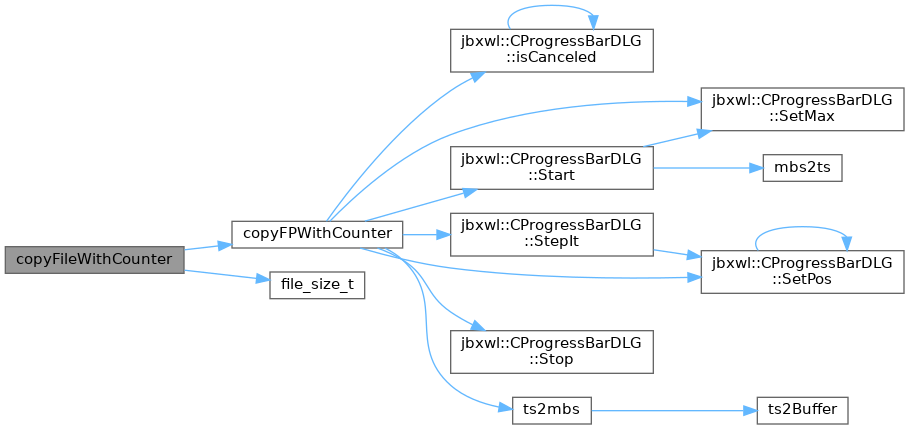

◆ copyFPWithCounter()
| int copyFPWithCounter | ( | FILE * | src, |
| FILE * | dst, | ||
| unsigned long int | sz ) |
int jbxwl::copyFPWithCounter(FILE* src, FILE* dst, unsigned long int sz)
戻り値: 正数 正常終了
0 処理失敗(何も処理されていない?)
-1 キャンセル
-2 読み込み/書き込みに失敗
-3 指定されたバイト数まで処理されていない
Definition at line 58 of file MFCio.cpp.
References IDD_PROGBAR, IDS_STR_WRTNG_FILE, CProgressBarDLG::isCanceled(), CProgressBarDLG::SetMax(), CProgressBarDLG::SetPos(), CProgressBarDLG::Start(), CProgressBarDLG::StepIt(), CProgressBarDLG::Stop(), and ts2mbs().
Referenced by copyFileWithCounter().
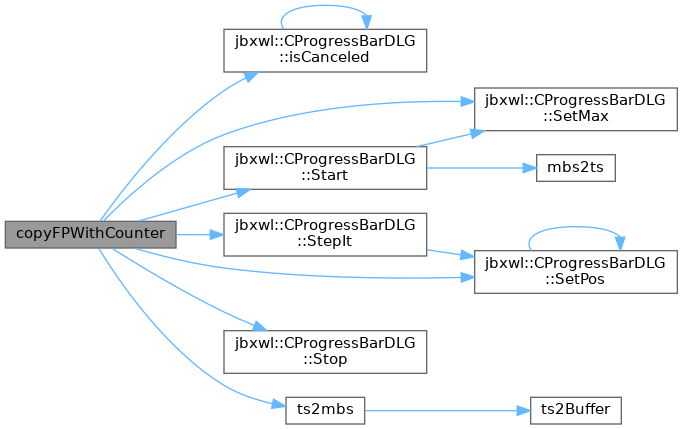

◆ CreateDocFrmView()
| CExFrame * CreateDocFrmView | ( | CMultiDocTemplate * | pDocTempl, |
| CAppCallBack * | papp = NULL ) |
CExFrame* jbxwl::CreateDocFrmView(CMultiDocTemplate* pDocTempl, CAppCallBack* papp)
Document, Frame, View の組み合わせを作成する.
Definition at line 38 of file ExClass.cpp.
References deleteNull(), CExDocument::GetView(), CExFrame::pTempl, and SetExLink().
Referenced by ExecTemplate().
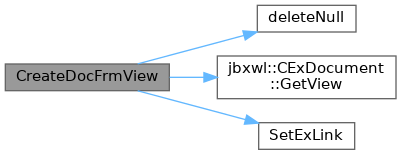

◆ cut_file_extension_t()
| CString cut_file_extension_t | ( | LPCTSTR | str | ) |
Definition at line 317 of file WinTools.cpp.
References mbs2ts(), and ts2mbs().

◆ deleteNull()
|
inline |
Definition at line 229 of file WinTools.h.
Referenced by CreateDocFrmView(), CWinAudioTool::free(), and CDxSRenderView::PrepareVB().

◆ DoSystemKeyAction()
| BOOL DoSystemKeyAction | ( | LPCTSTR | com, |
| BOOL | child = FALSE ) |
return TRUE: com の処理は完了した. FALSE: com の処理はまだ完了していない.
Definition at line 671 of file WinTools.cpp.
References SendKeyActionTap(), SendKeyActionTapAlt(), and SendKeyActionTapCtrl().

◆ Dx9CreateGraphic()
| LPDIRECT3DDEVICE9 Dx9CreateGraphic | ( | LPDIRECT3D9 | gpD3D, |
| D3DPRESENT_PARAMETERS * | d3dParam, | ||
| HWND | hWnd ) |
機能: DirectX9のグラフィックデバイスを得る. 引数: gpD3D DirectX9のインターフェイス d3dParam デバイス作成のためのパラメータ hWnd デバイスを作成するウィンドウのウィンドウハンドル
戻値: DirectX9デバイス 説明:
Definition at line 93 of file Dx9.cpp.
Referenced by CDxBaseView::InitDevice().
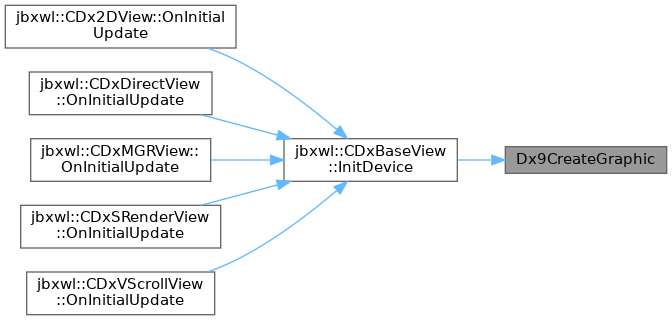
◆ Dx9CreateInterface()
| BOOL Dx9CreateInterface | ( | CWinApp * | wapp | ) |
機能: DirectX9のデバイスへのインターフェイスを得る. 引数: hinst アプリケーションのインスタンスハンドラ(通常は this->m_hInstanceを指定) 説明:
Definition at line 30 of file Dx9.cpp.
References DIRECTINPUT_VERSION, Dx9CreateKeyBoard(), Dx9CreateMouse(), DXRELEASE, GpD3D, GpDInput, GpDKeyBoard, and GpDMouse.

◆ Dx9CreateKeyBoard()
| LPDIRECTINPUTDEVICE8 Dx9CreateKeyBoard | ( | LPDIRECTINPUT8 | gpDInput, |
| HWND | hWnd ) |
Definition at line 151 of file Dx9.cpp.
Referenced by Dx9CreateInterface().

◆ Dx9CreateMouse()
| LPDIRECTINPUTDEVICE8 Dx9CreateMouse | ( | LPDIRECTINPUT8 | gpDInput, |
| HWND | hWnd ) |
Definition at line 114 of file Dx9.cpp.
Referenced by Dx9CreateInterface().

◆ Dx9DrawPrimitive()
| HRESULT Dx9DrawPrimitive | ( | LPDIRECT3DDEVICE9 | gpD3DDevice, |
| D3DPRIMITIVETYPE | ptype, | ||
| UINT | unit, | ||
| UINT | bsize ) |
Definition at line 335 of file Dx9.cpp.
References Dx9DividePrimitiveMode, and DXMAXPRIMITIVE.
Referenced by CDxSRenderView::ExecRender().

◆ Dx9GetBackBuffer()
| POINT Dx9GetBackBuffer | ( | LPDIRECT3DDEVICE9 | gpD3DDevice, |
| LPDIRECT3DSURFACE9 * | pgpBackBuffer ) |
Definition at line 175 of file Dx9.cpp.
References Dx9GetSurfaceSize().
Referenced by CDx2DView::InitObject(), CDxDirectView::InitObject(), CDxMGRView::InitObject(), CDxVScrollView::InitObject(), CDx2DView::OnInitialUpdate(), CDxDirectView::OnInitialUpdate(), CDxMGRView::OnInitialUpdate(), and CDxVScrollView::OnInitialUpdate().

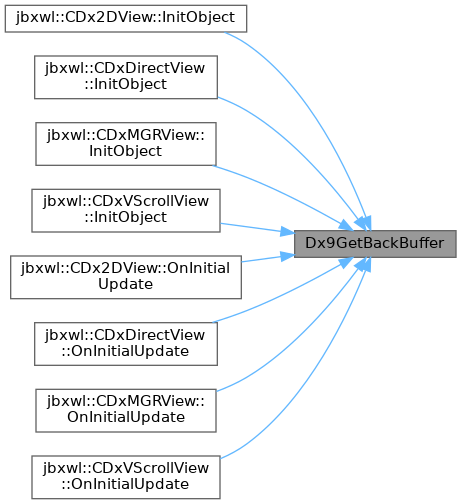
◆ Dx9GetSurfaceSize()
| POINT Dx9GetSurfaceSize | ( | LPDIRECT3DSURFACE9 * | lpsf | ) |
Definition at line 361 of file Dx9.cpp.
Referenced by Dx9GetBackBuffer().
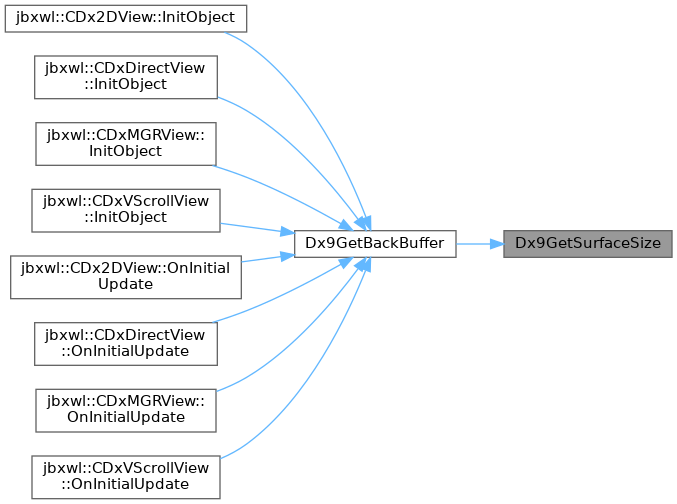
◆ Dx9ReleaseInterface()
| void Dx9ReleaseInterface | ( | ) |
◆ Dx9SurfaceFromByteMemory()
| BOOL Dx9SurfaceFromByteMemory | ( | LPDIRECT3DDEVICE9 | gpD3DDevice, |
| LPDIRECT3DSURFACE9 * | pgpSurface, | ||
| CmnHead | cmnHead ) |
Definition at line 236 of file Dx9.cpp.
Referenced by Dx9SurfaceFromMemory().

◆ Dx9SurfaceFromMemory()
| BOOL Dx9SurfaceFromMemory | ( | LPDIRECT3DDEVICE9 | gpD3DDevice, |
| LPDIRECT3DSURFACE9 * | pgpSurface, | ||
| CmnHead | cmnHead ) |
Definition at line 198 of file Dx9.cpp.
References Dx9SurfaceFromByteMemory(), and Dx9SurfaceFromMemoryFile().
Referenced by CDx2DView::InitObject(), and CDx2DView::OnInitialUpdate().


◆ Dx9SurfaceFromMemoryFile()
| BOOL Dx9SurfaceFromMemoryFile | ( | LPDIRECT3DDEVICE9 | gpD3DDevice, |
| LPDIRECT3DSURFACE9 * | pgpSurface, | ||
| CmnHead | cmnHead ) |
Definition at line 216 of file Dx9.cpp.
Referenced by Dx9SurfaceFromMemory().

◆ Dx9TextureFromByteMemory()
| BOOL Dx9TextureFromByteMemory | ( | LPDIRECT3DDEVICE9 | gpD3DDevice, |
| LPDIRECT3DTEXTURE9 * | pgpTexture, | ||
| CmnHead | cmnHead ) |
Definition at line 296 of file Dx9.cpp.
References DXRELEASE.
Referenced by Dx9TextureFromMemory().

◆ Dx9TextureFromMemory()
| BOOL Dx9TextureFromMemory | ( | LPDIRECT3DDEVICE9 | gpD3DDevice, |
| LPDIRECT3DTEXTURE9 * | pgpTexture, | ||
| CmnHead | cmnHead ) |
Definition at line 263 of file Dx9.cpp.
References Dx9TextureFromByteMemory(), and Dx9TextureFromMemoryFile().

◆ Dx9TextureFromMemoryFile()
| BOOL Dx9TextureFromMemoryFile | ( | LPDIRECT3DDEVICE9 | gpD3DDevice, |
| LPDIRECT3DTEXTURE9 * | pgpTexture, | ||
| CmnHead | cmnHead ) |
Definition at line 281 of file Dx9.cpp.
Referenced by Dx9TextureFromMemory().

◆ Dx9Word2ARGB()
|
inline |
Definition at line 88 of file Dx9.h.
Referenced by CDxSRenderView::PrepareVB().

◆ Dx9Word2RGB()
|
inline |
Definition at line 110 of file Dx9.h.
Referenced by CDxSRenderView::PrepareVB().

◆ Dx9Word2RGBA()
|
inline |
Definition at line 66 of file Dx9.h.
Referenced by CDxSRenderView::PrepareVB().

◆ EasyGetOpenFileName()
| CString EasyGetOpenFileName | ( | LPCTSTR | title = NULL, |
| HWND | hWnd = NULL ) |
CString jbxwl::EasyGetOpenFileName(LPCWSTR title, HWND hWnd) : UNICODE用 CString jbxwl::EasyGetOpenFileName(LPCTSTR title, HWND hWnd) : マルチバイト用
読み込み用ファイル名を得るためのダイアログを表示する.
- Parameters
-
title : ダイアログのタイトル. hWnd : ウィンドウハンドル
- Return values
-
CString : ファイルへのパス
Definition at line 271 of file ExClass.cpp.
Referenced by ExecTemplate().

◆ EasyGetSaveFileName()
| CString EasyGetSaveFileName | ( | LPCTSTR | title = NULL, |
| LPCTSTR | extnt = NULL, | ||
| HWND | hWnd = NULL ) |
CString jbxwl::EasyGetSaveFileName(LPCWSTR title, LPCWSTR extnt, HWND hWnd) : UNICODE用 CString jbxwl::EasyGetSaveFileName(LPCTSTR title, LPCTSTR extnt, HWND hWnd) : マルチバイト用
保存用ファイル名を得るためのダイアログを表示する.
- Parameters
-
title : ダイアログのタイトル. extnt : 保存用ファイルの拡張子 hWnd : ウィンドウハンドル
- Return values
-
CString : ファイルへのパス
Definition at line 317 of file ExClass.cpp.
◆ EasyGetSaveFolderName()
| CString EasyGetSaveFolderName | ( | LPCTSTR | folder = _T(""), |
| LPCTSTR | title = NULL, | ||
| HWND | hWnd = NULL ) |
CString jbxwl::EasyGetSaveFolderName(LPCTSTR folder, LPCTSTR title, HWND hWnd)
保存用フォルダ名を得るためのダイアログを表示する.
- Bug
- おそらく UNICODEでは動かない?
Definition at line 352 of file ExClass.cpp.
References EasyGetSaveFolderNameCallBack().

◆ EasyGetSaveFolderNameCallBack()
| int CALLBACK EasyGetSaveFolderNameCallBack | ( | HWND | hwnd, |
| UINT | uMsg, | ||
| LPARAM | lParam, | ||
| LPARAM | lpData ) |
int CALLBACK jbxwl::EasyGetSaveFolderNameCallBack(HWND hwnd, UINT uMsg, LPARAM lParam, LPARAM lpData)
EasyGetSaveFolderName() 用コールバック関数.
Definition at line 387 of file ExClass.cpp.
Referenced by EasyGetSaveFolderName().

◆ ExecDocFrmView()
| int ExecDocFrmView | ( | CExFrame * | pfrm, |
| LPCTSTR | fname = NULL ) |
int jbxwl::ExecDocFrmView(CExFrame* pfrm, LPCTSTR fname)
フレームに関連付けれたクラスを使用して,データ読み込み,表示を行う.
データの読み込みには InitialDocView() を使用する
Definition at line 99 of file ExClass.cpp.
References CExFrame::cancelOperation, CExFrame::doneErrorMessage, get_file_name_t(), CExDocument::hasReadData, CExDocument::hasViewData, CExView::hasViewData, InitialDocView(), MSG_DFV_CANCEL, MSG_DFV_ERR_READ, MSG_DFV_FAIL_VIEW, MSG_DFV_NOT_DISP, MSG_DFV_UNVISIBLE, CExFrame::pDoc, CExDocument::preTitle, CExFrame::preTitle, CExDocument::pstTitle, CExFrame::pView, CExView::SetTitle(), CExDocument::Title, CExFrame::Title, and CExView::Title.
Referenced by ExecTemplate().


◆ ExecDocFrmViewError()
| void ExecDocFrmViewError | ( | HWND | hwnd, |
| int | ret ) |
void jbxwl::ExecDocFrmViewError(HWND hwnd, int ret)
jbxwl::ExecDocFrmView() のエラーを処理する.
Definition at line 148 of file ExClass.cpp.
References IDS_STR_CANCEL_OPRTN, IDS_STR_ERR_OPEN_FILE, IDS_STR_ERR_PREDISP, IDS_STR_ERR_UNDISP, IDS_STR_NULLPT_FRM, MSG_DFV_CANCEL, MSG_DFV_ERR_READ, MSG_DFV_FAIL_VIEW, MSG_DFV_FR_NULL, and MSG_DFV_UNVISIBLE.
Referenced by ExecTemplate().

◆ ExecLogWnd()
| CLogWndFrame * ExecLogWnd | ( | CMultiDocTemplate * | pDocTempl, |
| LPCTSTR | title, | ||
| CAppCallBack * | app ) |
Definition at line 151 of file LogWndFrame.cpp.
References CLogWndDoc::GetView(), CExTextFrame::pApp, CExTextView::pApp, CLogWndFrame::pDoc, CLogWndView::pDoc, CLogWndDoc::pFrame, CLogWndView::pFrame, CExTextFrame::pTempl, CLogWndDoc::pView, CLogWndFrame::pView, CLogWndView::SetTitle(), and CExTextFrame::Title.

◆ ExecTemplate()
| int ExecTemplate | ( | CMultiDocTemplate * | ptemp, |
| ExMSGraph< sWord > * | pmsGraph = NULL, | ||
| ExCmnHead * | pcmnHead = NULL, | ||
| CExFrame * | prntFrm = NULL, | ||
| int | viewPoint = 0 ) |
テンプレートを起動する.
渡すデータに対してメモリ管理機能あり.
メモリ管理していないデータを渡した場合は,クリアされる.
Definition at line 187 of file ExClass.cpp.
References CExDocument::cmnHead, CExDocument::colorMode, CExFrame::colorMode, CreateDocFrmView(), CExDocument::ctrlCntrst, EasyGetOpenFileName(), ExecDocFrmView(), ExecDocFrmViewError(), CExDocument::hasReadData, CExDocument::hasViewData, IDS_STR_OPEN_FILE, CExDocument::msGraph, CExDocument::multiSliceData, CExFrame::pDoc, CExDocument::preTitle, CExDocument::pstTitle, CExFrame::pView, CExDocument::Title, and CExView::vSBpos.
Referenced by CvThumbNailFrame::onLButtonDBLClick().
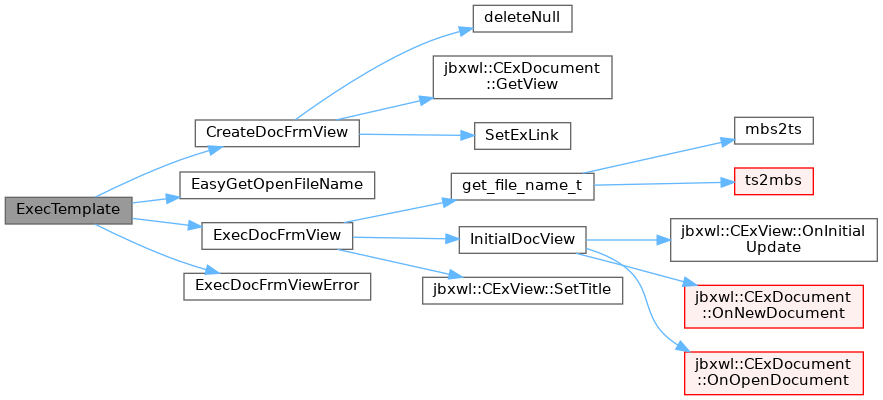

◆ file_exist_t()
| BOOL file_exist_t | ( | LPCTSTR | fn | ) |
Definition at line 258 of file WinTools.cpp.
Referenced by CNiFileTool::open_wfile(), and CNiFileTool::saveJTextfromFile().

◆ file_size_t()
| unsigned long int file_size_t | ( | LPCTSTR | fn | ) |
Definition at line 250 of file WinTools.cpp.
Referenced by copyFileWithCounter().

◆ freeFramesData()
| void freeFramesData | ( | NiFrameData * | frmdata, |
| int | frm_num ) |
NiFrameData* jbxwl::makeFramesData(int frame, int jnum)
フレームデータの格納先メモリ(ジョイント数固定)を作成,初期化.
フレーム毎のジョイント数,フレーム間隔が一定
- Parameters
-
frame フレームの数 joint_num ジョイントの数
- Returns
- フレームデータを格納するデータ領域へのポインタ
Definition at line 788 of file NiJointsTool.cpp.
References NiFrameData::jdat.
Referenced by CBaseFrameTool::free_data(), CNiVMDTool::free_data(), and makeFramesData().
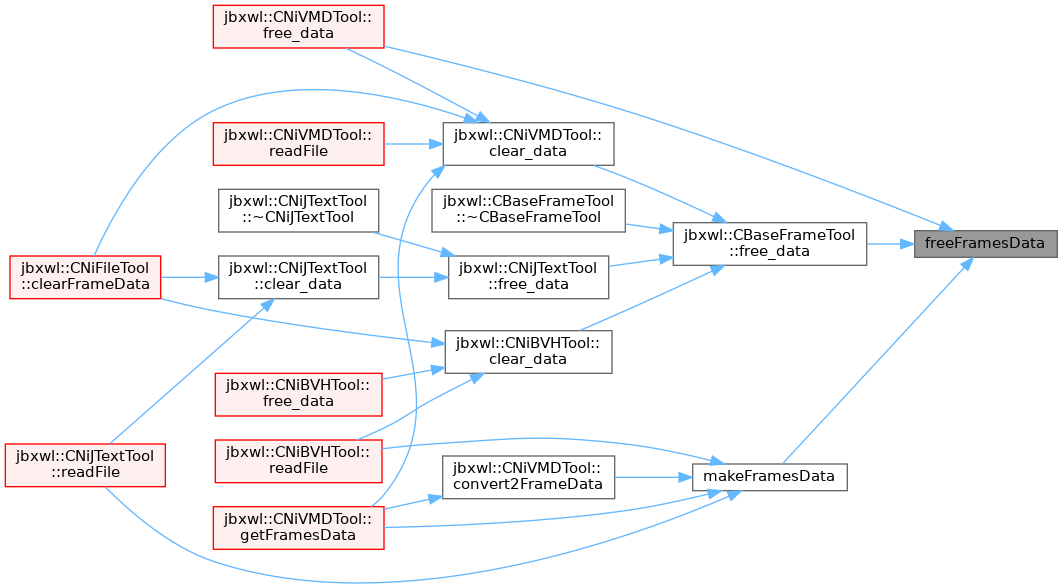
◆ get_dir_files_rcsv_t()
| tList * get_dir_files_rcsv_t | ( | LPCTSTR | dirn | ) |
Definition at line 370 of file WinTools.cpp.
References get_dir_files_rcsv_t(), get_dir_files_t(), and mbs2ts().
Referenced by get_dir_files_rcsv_t().


◆ get_dir_files_t()
| tList * get_dir_files_t | ( | LPCTSTR | dirn | ) |
Definition at line 338 of file WinTools.cpp.
References cat_ts2Buffer(), ts2Buffer(), and ts2mbs().
Referenced by get_dir_files_rcsv_t(), and DLLModuleTBL::get_dir_module().


◆ get_file_name_t()
| CString get_file_name_t | ( | LPCTSTR | str | ) |
Definition at line 277 of file WinTools.cpp.
References mbs2ts(), and ts2mbs().
Referenced by ExecDocFrmView(), and CRwGRDoc::ReadDataFile().


◆ get_tstr_param_tList()
| CString get_tstr_param_tList | ( | tList * | lt, |
| char * | key, | ||
| LPCTSTR | dflt ) |
Definition at line 413 of file WinTools.cpp.
References mbs2ts().

◆ GetCurrentFolder()
| CString GetCurrentFolder | ( | void | ) |
Definition at line 539 of file WinTools.cpp.
◆ GetCurrentUserHomeFolder()
| CString GetCurrentUserHomeFolder | ( | void | ) |
Definition at line 460 of file WinTools.cpp.
Referenced by MakeWorkingFolderPath().

◆ GetDefaultUserHomeFolder()
| CString GetDefaultUserHomeFolder | ( | void | ) |
Definition at line 475 of file WinTools.cpp.
◆ GetMenu_byID()
| CMenu * GetMenu_byID | ( | CMenu * | pMenu, |
| UINT | id ) |
メニューでリソースID id を持つものを探す.
Definition at line 18 of file MFCTool.cpp.
References GetMenu_byID().
Referenced by GetMenu_byID().


◆ GetMenu_byName()
| CMenu * GetMenu_byName | ( | CMenu * | pMenu, |
| LPCTSTR | name ) |
Definition at line 46 of file MFCTool.cpp.
References GetMenu_byName().
Referenced by GetMenu_byName(), and GetMenu_byStringID().


◆ GetMenu_byStringID()
| CMenu * GetMenu_byStringID | ( | CMenu * | pMenu, |
| UINT | id ) |
Definition at line 34 of file MFCTool.cpp.
References GetMenu_byName(), and LoadString_byID().

◆ GetMouseCursorType()
| TCHAR * GetMouseCursorType | ( | void | ) |
Definition at line 749 of file WinTools.cpp.
References MouseCursolTable.
Referenced by CExTextView::GetWindowReSize(), and CExView::GetWindowReSize().

◆ GetMsecondsLapTimer()
| unsigned short GetMsecondsLapTimer | ( | unsigned short | pm, |
| unsigned short * | nt = NULL ) |
unsigned short jbxwl::GetMsecondsLapTimer(unsigned short pm, unsigned short* nt)
ラップタイムを返す.
Definition at line 799 of file WinTools.cpp.
Referenced by CNiFileTool::nextFrame().

◆ GetMsecondsTimer()
| unsigned short GetMsecondsTimer | ( | void | ) |
unsigned short jbxwl::GetMsecondsTimer()
1分計.0-59999ms を返す.
Definition at line 778 of file WinTools.cpp.
Referenced by CNiFileTool::startFrame(), and CNiFileTool::writeJTextData().

◆ GetProgramFolder()
| CString GetProgramFolder | ( | void | ) |
Definition at line 508 of file WinTools.cpp.
References GetProgramFolderA(), and mbs2ts().

◆ GetProgramFolderA()
| char * GetProgramFolderA | ( | void | ) |
Definition at line 519 of file WinTools.cpp.
References ts2mbs().
Referenced by GetProgramFolder().


◆ getQAvBVHOffset()
| vector getQAvBVHOffset | ( | int | joint | ) |
Definition at line 341 of file NiBVHName.cpp.
References _QAV_Offset.
Referenced by CNiFileTool::writeBVHFile().

◆ getResourceLocale()
| CString getResourceLocale | ( | void | ) |
Definition at line 444 of file WinTools.cpp.
References IDS_STR_LOCALE, and LoadString_byID().

◆ InitialDocView()
| BOOL InitialDocView | ( | CExFrame * | pfrm, |
| LPCTSTR | fname ) |
BOOL jbxwl::InitialDocView(CExFrame* pfrm, LPCTSTR fname)
Document, View クラスの前処理.
ファイルをオープンし,表示の準備をする.
Definition at line 73 of file ExClass.cpp.
References CExView::hasViewData, CExView::OnInitialUpdate(), CExDocument::OnNewDocument(), CExDocument::OnOpenDocument(), CExFrame::pDoc, and CExFrame::pView.
Referenced by ExecDocFrmView().


◆ InputFloatNumDLG()
| BOOL InputFloatNumDLG | ( | LPCTSTR | title, |
| double * | val ) |
Definition at line 313 of file InputNumDLG.cpp.
References CInputFloatNumDLG::val.
◆ InputMultiFloatNumDLG()
| BOOL InputMultiFloatNumDLG | ( | LPCTSTR | t0, |
| double * | v0, | ||
| LPCTSTR | t1 = NULL, | ||
| double * | v1 = NULL, | ||
| LPCTSTR | t2 = NULL, | ||
| double * | v2 = NULL, | ||
| LPCTSTR | t3 = NULL, | ||
| double * | v3 = NULL, | ||
| LPCTSTR | t4 = NULL, | ||
| double * | v4 = NULL, | ||
| LPCTSTR | t5 = NULL, | ||
| double * | v5 = NULL ) |
Definition at line 328 of file InputNumDLG.cpp.
References CInputMultiFloatNumDLG::val.
◆ InputNumDLG()
| BOOL InputNumDLG | ( | LPCTSTR | title, |
| int * | val ) |
Definition at line 298 of file InputNumDLG.cpp.
References CInputNumDLG::val.
◆ JointName2NiSDK()
| int JointName2NiSDK | ( | char * | jname, |
| NiSDK_Lib | lib ) |
Definition at line 459 of file NiJointsTool.cpp.
References _NiJointName, Ni2SDKJointNum, and NI_TOTAL_JOINT_NUM.
◆ LoadString_byID()
|
inline |
Definition at line 174 of file WinTools.h.
Referenced by GetMenu_byStringID(), getResourceLocale(), and setResourceLocale().
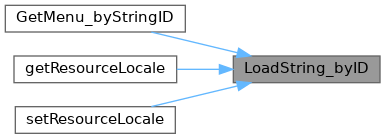
◆ make_file_path_t()
| CString make_file_path_t | ( | LPCTSTR | str | ) |
Definition at line 295 of file WinTools.cpp.
References mbs2ts(), and ts2mbs().

◆ makeBVH_NiHierarchy()
| tTree * makeBVH_NiHierarchy | ( | void | ) |
Definition at line 247 of file NiBVHName.cpp.
Referenced by CNiFileTool::writeBVHFile().

◆ makeBVH_QAvHierarchy()
| tTree * makeBVH_QAvHierarchy | ( | void | ) |
Definition at line 205 of file NiBVHName.cpp.
Referenced by CNiFileTool::writeBVHFile().

◆ makeBVH_SLHierarchy()
| tTree * makeBVH_SLHierarchy | ( | void | ) |
Definition at line 150 of file NiBVHName.cpp.
Referenced by CNiFileTool::writeBVHFile().

◆ makeFramesData()
| NiFrameData * makeFramesData | ( | int | frame, |
| int | jnum, | ||
| int * | frame_num ) |
NiFrameData* jbxwl::makeVarFrameData(int frame, int* joint_num, int* frame_num)
フレームデータの格納先メモリ(フレーム毎のジョイント数とフレーム間隔が可変)を作成,初期化.
- Parameters
-
frame フレームの数 joint_num ジョイント数 frame_num フレームの番号(時間)の入った配列.NULLならフレーム間隔一定.
- Returns
- フレームデータを格納するデータ領域へのポインタ
Definition at line 718 of file NiJointsTool.cpp.
References freeFramesData(), NiFrameData::frmn, NiJointData::index, NiFrameData::jdat, NiFrameData::jnum, NiJointData::joint, NiFrameData::msec, NiJointData::quat, and NiJointData::vect.
Referenced by CNiVMDTool::convert2FrameData(), CNiVMDTool::getFramesData(), CNiBVHTool::readFile(), and CNiJTextTool::readFile().


◆ MakeWorkingFolderPath()
| CString MakeWorkingFolderPath | ( | LPCTSTR | fnm, |
| BOOL | local, | ||
| LPCTSTR | dir = NULL, | ||
| BOOL | make = FALSE ) |
Definition at line 487 of file WinTools.cpp.
References GetCurrentUserHomeFolder(), and ts2mbs().

◆ mbs2ts()
| CString mbs2ts | ( | char * | str | ) |
Definition at line 79 of file WinTools.cpp.
Referenced by cut_file_extension_t(), CWinSharedMem::CWinSharedMem(), get_dir_files_rcsv_t(), DLLModuleTBL::get_dir_module(), get_file_name_t(), DLLModule::get_module_info(), get_tstr_param_tList(), CLogWndView::getCopyData(), GetProgramFolder(), make_file_path_t(), CLogWndView::OnDraw(), CRwGRDoc::ReadDataFile(), CProgressBarDLG::SetTitle(), CProgressTextDLG::SetTitle(), CProgressBarDLG::Start(), and CProgressTextDLG::Start().
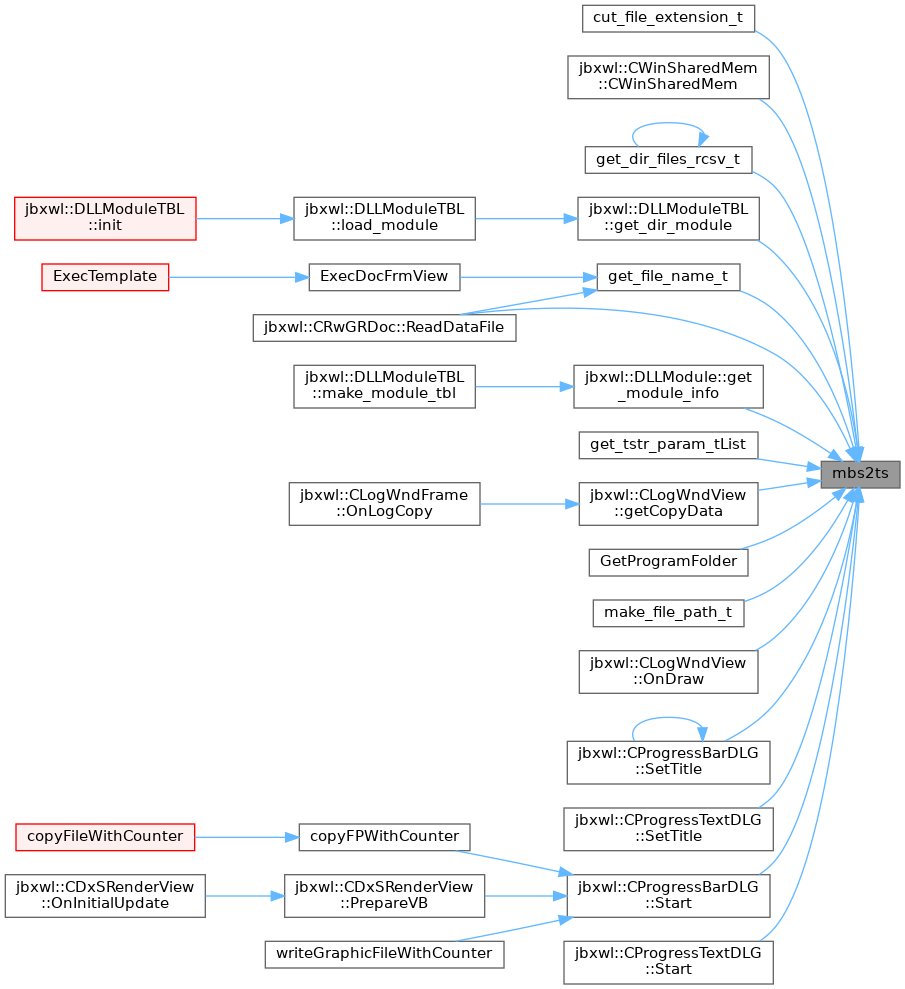
◆ MessageBoxDLG() [1/8]
| CMessageBoxDLG * MessageBoxDLG | ( | int | ttl, |
| int | msg, | ||
| CWnd * | wnd = NULL ) |
Definition at line 142 of file MessageBoxDLG.cpp.
References CMessageBoxDLG::Display().
Referenced by CLogWndFrame::OnLogSave(), CNiFileTool::open_wfile(), and CNiFileTool::saveJTextfromFile().


◆ MessageBoxDLG() [2/8]
| int MessageBoxDLG | ( | int | ttl, |
| int | msg, | ||
| UINT | type, | ||
| CWnd * | wnd = NULL ) |
Definition at line 193 of file MessageBoxDLG.cpp.
References MessageDLG().

◆ MessageBoxDLG() [3/8]
| CMessageBoxDLG * MessageBoxDLG | ( | int | ttl, |
| LPCTSTR | msg, | ||
| CWnd * | wnd = NULL ) |
Definition at line 167 of file MessageBoxDLG.cpp.
References CMessageBoxDLG::Display().

◆ MessageBoxDLG() [4/8]
| int MessageBoxDLG | ( | int | ttl, |
| LPCTSTR | msg, | ||
| UINT | type, | ||
| CWnd * | wnd = NULL ) |
Definition at line 220 of file MessageBoxDLG.cpp.
References MessageDLG().

◆ MessageBoxDLG() [5/8]
| CMessageBoxDLG * MessageBoxDLG | ( | LPCTSTR | ttl, |
| int | msg, | ||
| CWnd * | wnd = NULL ) |
Definition at line 155 of file MessageBoxDLG.cpp.
References CMessageBoxDLG::Display().

◆ MessageBoxDLG() [6/8]
| int MessageBoxDLG | ( | LPCTSTR | ttl, |
| int | msg, | ||
| UINT | type, | ||
| CWnd * | wnd = NULL ) |
Definition at line 207 of file MessageBoxDLG.cpp.
References MessageDLG().

◆ MessageBoxDLG() [7/8]
| CMessageBoxDLG * MessageBoxDLG | ( | LPCTSTR | ttl, |
| LPCTSTR | msg, | ||
| CWnd * | wnd = NULL ) |
Definition at line 179 of file MessageBoxDLG.cpp.
References CMessageBoxDLG::Display().

◆ MessageBoxDLG() [8/8]
| int MessageBoxDLG | ( | LPCTSTR | ttl, |
| LPCTSTR | msg, | ||
| UINT | type, | ||
| CWnd * | wnd = NULL ) |
Definition at line 233 of file MessageBoxDLG.cpp.
References MessageDLG().

◆ MessageDLG()
| int MessageDLG | ( | LPCTSTR | ttl, |
| LPCTSTR | msg, | ||
| UINT | type, | ||
| HWND | hWnd ) |
Definition at line 576 of file WinTools.cpp.
Referenced by MessageBoxDLG(), MessageBoxDLG(), MessageBoxDLG(), and MessageBoxDLG().
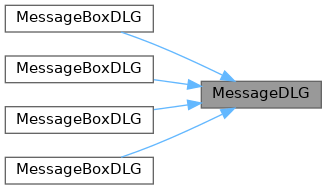
◆ Ni2SDKPosJointNum()
| int Ni2SDKPosJointNum | ( | int | joint, |
| NiSDK_Lib | lib ) |
Definition at line 342 of file NiJointsTool.cpp.
References _Ni2KinectPosJointNum, _Ni2OpenNI2PosJointNum, _Ni2OpenNIPosJointNum, NiSDK_Kinect, NiSDK_None, NiSDK_OpenNI, and NiSDK_OpenNI2.
Referenced by CNiJoints::copyJoints2NiJoints().

◆ Ni2SDKRotJointNum()
| int Ni2SDKRotJointNum | ( | int | joint, |
| NiSDK_Lib | lib ) |
Definition at line 419 of file NiJointsTool.cpp.
References _Ni2KinectRotJointNum, _Ni2OpenNI2RotJointNum, _Ni2OpenNIRotJointNum, _Ni2RotJointNum, NiSDK_Kinect, NiSDK_None, NiSDK_OpenNI, and NiSDK_OpenNI2.
Referenced by CNiJoints::copyJoints2NiJoints(), and NiCorrectJointsRotation().

◆ NiCorrectJointEuler()
| void NiCorrectJointEuler | ( | int | joint, |
| Quaternion< double > * | quat, | ||
| RBound< double > | rb ) |
Definition at line 923 of file NiJointsTool.cpp.
References NiGetJointEuler(), and NiSetJointEuler().
Referenced by NiCorrectJointsRotation().


◆ NiCorrectJointsRotation()
| void NiCorrectJointsRotation | ( | Quaternion< double > * | quat, |
| NiSDK_Lib | lib ) |
Definition at line 845 of file NiJointsTool.cpp.
References Ni2SDKRotJointNum(), NI_CHEST, NI_HEAD, NI_L_ANKLE, NI_L_COLLAR, NI_L_ELBOW, NI_L_FOOT, NI_L_HAND, NI_L_HIP, NI_L_KNEE, NI_L_SHLDR, NI_L_WRIST, NI_NECK, NI_R_ANKLE, NI_R_COLLAR, NI_R_ELBOW, NI_R_FOOT, NI_R_HAND, NI_R_HIP, NI_R_KNEE, NI_R_SHLDR, NI_R_WRIST, NI_TORSO, NiCorrectJointEuler(), RBound_NI_CHEST, RBound_NI_HEAD, RBound_NI_L_ANKLE, RBound_NI_L_COLLAR, RBound_NI_L_ELBOW, RBound_NI_L_FOOT, RBound_NI_L_HAND, RBound_NI_L_HIP, RBound_NI_L_KNEE, RBound_NI_L_SHLDR, RBound_NI_L_WRIST, RBound_NI_NECK, RBound_NI_R_ANKLE, RBound_NI_R_COLLAR, RBound_NI_R_ELBOW, RBound_NI_R_FOOT, RBound_NI_R_HAND, RBound_NI_R_HIP, RBound_NI_R_KNEE, RBound_NI_R_SHLDR, RBound_NI_R_WRIST, and RBound_NI_TORSO.

◆ NiGetJointEuler()
| void NiGetJointEuler | ( | int | joint, |
| Quaternion< double > * | quat, | ||
| Vector< double > * | vect ) |
Definition at line 961 of file NiJointsTool.cpp.
References NI_L_ANKLE, NI_L_COLLAR, NI_L_ELBOW, NI_L_SHLDR, NI_L_WRIST, NI_R_ANKLE, NI_R_COLLAR, NI_R_ELBOW, NI_R_SHLDR, and NI_R_WRIST.
Referenced by NiCorrectJointEuler().

◆ NiGetSkeletonColor()
| unsigned int NiGetSkeletonColor | ( | int | label | ) |
Definition at line 45 of file NiToolWin.cpp.
References NI_DETECT_COLOR_BRIGHT.
◆ NiInitRBoundJointsRotation()
| void NiInitRBoundJointsRotation | ( | void | ) |
Definition at line 812 of file NiJointsTool.cpp.
References RBound_NI_CHEST, RBound_NI_HEAD, RBound_NI_L_ANKLE, RBound_NI_L_COLLAR, RBound_NI_L_ELBOW, RBound_NI_L_FOOT, RBound_NI_L_HAND, RBound_NI_L_HIP, RBound_NI_L_KNEE, RBound_NI_L_SHLDR, RBound_NI_L_WRIST, RBound_NI_NECK, RBound_NI_R_ANKLE, RBound_NI_R_COLLAR, RBound_NI_R_ELBOW, RBound_NI_R_FOOT, RBound_NI_R_HAND, RBound_NI_R_HIP, RBound_NI_R_KNEE, RBound_NI_R_SHLDR, RBound_NI_R_WRIST, and RBound_NI_TORSO.
◆ NiJointName()
| std::string NiJointName | ( | int | n | ) |
Definition at line 117 of file NiJointsTool.cpp.
References _NiJointName, and NI_TOTAL_JOINT_NUM.
Referenced by addBVHJointName(), setBVHJointName(), and CNiJTextTool::writeCurrentData().

◆ NiJointNum()
| int NiJointNum | ( | char * | name | ) |
Definition at line 130 of file NiJointsTool.cpp.
References _NiJointName, and NI_TOTAL_JOINT_NUM.
Referenced by CNiJTextTool::readFile().

◆ NiSDK2JointName()
| std::string NiSDK2JointName | ( | int | joint, |
| NiSDK_Lib | lib ) |
Definition at line 188 of file NiJointsTool.cpp.
References _Kinect2JointNameNum, _NiJointName, _OpenNI22JointNameNum, _OpenNI2JointNameNum, NiSDK_Kinect, NiSDK_None, NiSDK_OpenNI, and NiSDK_OpenNI2.
◆ NiSDKMirrorJointNum()
| int NiSDKMirrorJointNum | ( | int | joint, |
| NiSDK_Lib | lib ) |
Definition at line 261 of file NiJointsTool.cpp.
References _KinectMirrorJointNum, _NiMirrorJointNum, _OpenNI2MirrorJointNum, _OpenNIMirrorJointNum, NiSDK_Kinect, NiSDK_None, NiSDK_OpenNI, and NiSDK_OpenNI2.
Referenced by CNiJTextTool::setJntAngl(), CNiJTextTool::setPosVect(), and CNiJTextTool::setRotQuat().

◆ NiSetJointEuler()
| void NiSetJointEuler | ( | int | joint, |
| Vector< double > * | vect, | ||
| Quaternion< double > * | quat ) |
Definition at line 1016 of file NiJointsTool.cpp.
References NI_L_ANKLE, NI_L_COLLAR, NI_L_ELBOW, NI_L_SHLDR, NI_L_WRIST, NI_R_ANKLE, NI_R_COLLAR, NI_R_ELBOW, NI_R_SHLDR, and NI_R_WRIST.
Referenced by NiCorrectJointEuler().

◆ NiSetKinectJointNums()
| void NiSetKinectJointNums | ( | void | ) |
Definition at line 575 of file NiJointsTool.cpp.
References NI_SDK_AVATAR, NI_SDK_FACE, NI_SDK_HEAD, NI_SDK_L_ANKLE, NI_SDK_L_BUST, NI_SDK_L_ELBOW, NI_SDK_L_EYE, NI_SDK_L_FINGER, NI_SDK_L_FNGRTIP, NI_SDK_L_FOOT, NI_SDK_L_HAND, NI_SDK_L_HIP, NI_SDK_L_KNEE, NI_SDK_L_SHLDR, NI_SDK_L_WRIST, NI_SDK_NECK, NI_SDK_PELVIS, NI_SDK_R_ANKLE, NI_SDK_R_BUST, NI_SDK_R_ELBOW, NI_SDK_R_EYE, NI_SDK_R_FINGER, NI_SDK_R_FNGRTIP, NI_SDK_R_FOOT, NI_SDK_R_HAND, NI_SDK_R_HIP, NI_SDK_R_KNEE, NI_SDK_R_SHLDR, NI_SDK_R_WRIST, and NI_SDK_TORSO.
◆ NiSetOpenNI2JointNums()
| void NiSetOpenNI2JointNums | ( | void | ) |
Definition at line 530 of file NiJointsTool.cpp.
References NI_SDK_AVATAR, NI_SDK_FACE, NI_SDK_HEAD, NI_SDK_L_ANKLE, NI_SDK_L_BUST, NI_SDK_L_ELBOW, NI_SDK_L_EYE, NI_SDK_L_FINGER, NI_SDK_L_FNGRTIP, NI_SDK_L_FOOT, NI_SDK_L_HAND, NI_SDK_L_HIP, NI_SDK_L_KNEE, NI_SDK_L_SHLDR, NI_SDK_L_WRIST, NI_SDK_NECK, NI_SDK_PELVIS, NI_SDK_R_ANKLE, NI_SDK_R_BUST, NI_SDK_R_ELBOW, NI_SDK_R_EYE, NI_SDK_R_FINGER, NI_SDK_R_FNGRTIP, NI_SDK_R_FOOT, NI_SDK_R_HAND, NI_SDK_R_HIP, NI_SDK_R_KNEE, NI_SDK_R_SHLDR, NI_SDK_R_WRIST, and NI_SDK_TORSO.
◆ NiSetOpenNIJointNums()
| void NiSetOpenNIJointNums | ( | void | ) |
Definition at line 485 of file NiJointsTool.cpp.
References NI_SDK_AVATAR, NI_SDK_FACE, NI_SDK_HEAD, NI_SDK_L_ANKLE, NI_SDK_L_BUST, NI_SDK_L_ELBOW, NI_SDK_L_EYE, NI_SDK_L_FINGER, NI_SDK_L_FNGRTIP, NI_SDK_L_FOOT, NI_SDK_L_HAND, NI_SDK_L_HIP, NI_SDK_L_KNEE, NI_SDK_L_SHLDR, NI_SDK_L_WRIST, NI_SDK_NECK, NI_SDK_PELVIS, NI_SDK_R_ANKLE, NI_SDK_R_BUST, NI_SDK_R_ELBOW, NI_SDK_R_EYE, NI_SDK_R_FINGER, NI_SDK_R_FNGRTIP, NI_SDK_R_FOOT, NI_SDK_R_HAND, NI_SDK_R_HIP, NI_SDK_R_KNEE, NI_SDK_R_SHLDR, NI_SDK_R_WRIST, and NI_SDK_TORSO.
◆ NiSetUserColor()
| void NiSetUserColor | ( | int | label, |
| uByte * | ptr, | ||
| BOOL | use_image = TRUE ) |
Definition at line 13 of file NiToolWin.cpp.
References NI_DETECT_COLOR_BRIGHT.
◆ numbering_name_t()
| CString numbering_name_t | ( | LPCTSTR | fmt, |
| int | n ) |
Definition at line 403 of file WinTools.cpp.
Referenced by CDxMGRView::MakeSetTitle(), and CRwGRDoc::ReadDataFile().

◆ open_shm_debuger()
| void open_shm_debuger | ( | void | ) |
Definition at line 106 of file WinSMTool.cpp.
References _Debug_SHM.
◆ read_index_tList_file_t()
| tList * read_index_tList_file_t | ( | LPCTSTR | fn, |
| char | cc ) |
Definition at line 387 of file WinTools.cpp.
References ts2mbs().

◆ RebootProgram()
| void RebootProgram | ( | void | ) |
Definition at line 69 of file MFCTool.cpp.
References SendWinMessage().

◆ releaseNull()
|
inline |
Definition at line 220 of file WinTools.h.
Referenced by CWinAudioTool::free().

◆ ResetDx9Device()
| HRESULT ResetDx9Device | ( | LPDIRECT3DDEVICE9 | lpD3DDevice, |
| D3DPRESENT_PARAMETERS * | pd3dParam, | ||
| CDxBaseView * | pviw = NULL ) |
HRESULT ResetDx9Device(LPDIRECT3DDEVICE9, D3DPRESENT_PARAMETERS*, CDxBaseView* pviw=NULL);
機能: DirectX9のデバイスをリセットする.
引数: lpD3DDevice リセットするDirectX9デバイス
d3dParam デバイスリセットのためのパラメータ.作成時に使用したものを指定する.
pviw このデバイスを持っている CDxBaseViewクラスを指定する.省略可能(NULL)
戻値: リセットの HRESULT
説明: D3DPOOL_DEFAULT管理のリソースなどは,デバイスのリセットを行う前にそれを開放し,
リセット後に再び獲得しなければならない.pviwに CDxBaseViewクラスのポインタを設定
した場合,解放関数として pviw->ClearObject() が呼び出され,再獲得関数として
pviw->InitObject()が呼び出される.この2つの関数は,CDxBaseViewクラスの継承クラス
の中でオーバーライドされなければならない.pviw に NULLを指定した場合は,リソース
の開放・再獲得は行われない.
CDxBaseView* を引数に持つので,Dx9.cpp へは入れられない.
機能: DirectX9のデバイスをリセットする.
引数: lpD3DDevice リセットするDirectX9デバイス d3dParam デバイスリセットのためのパラメータ.作成時に使用したものを指定する. pviw このデバイスを持っている CDxBaseViewクラスを指定する.省略可能(NULL)
戻値: リセットの HRESULT
説明: D3DPOOL_DEFAULT管理のリソースなどは,デバイスのリセットを行う前にそれを開放し, リセット後に再び獲得しなければならない.pviwに CDxBaseViewクラスのポインタを設定 した場合,解放関数として pviw->ClearObject() が呼び出され,再獲得関数として pviw->InitObject()が呼び出される.この2つの関数は,CDxBaseViewクラスの継承クラス の中でオーバーライドされなければならない.pviw に NULLを指定した場合は,リソース の開放・再獲得は行われない.
CDxBaseView* を引数に持つので,Dx9.cpp へは入れられない.
Definition at line 347 of file DxBaseClass.cpp.
References CDxBaseView::ClearObject(), and CDxBaseView::InitObject().
Referenced by CDx2DView::ExecRender(), CDxSRenderView::ExecRender(), CDxVScrollView::ExecRender(), CDxDirectView::ExecRender(), and CDxMGRView::ExecRender().


◆ SaveToClipboard()
| void SaveToClipboard | ( | void * | ptr, |
| size_t | len ) |
Definition at line 595 of file WinTools.cpp.
Referenced by SaveToClipboard_byStr().

◆ SaveToClipboard_byStr()
| void SaveToClipboard_byStr | ( | CString | data | ) |
Definition at line 587 of file WinTools.cpp.
References SaveToClipboard().

◆ SendKeyAction()
| void SendKeyAction | ( | WORD | key, |
| SENDKEY_Action | action ) |
Definition at line 628 of file WinTools.cpp.
References SENDKEY_DownAction, SENDKEY_TapAction, and SENDKEY_UpAction.
Referenced by SendKeyActionTap(), SendKeyActionTap(), and SendKeyActionTap().

◆ SendKeyActionTap() [1/3]
|
inline |
Definition at line 144 of file WinTools.h.
References SENDKEY_TapAction, and SendKeyAction().
Referenced by DoSystemKeyAction(), SendKeyActionTapAlt(), SendKeyActionTapCtrl(), and SendKeyActionTapShift().


◆ SendKeyActionTap() [2/3]
| void SendKeyActionTap | ( | WORD | key1, |
| WORD | key2 ) |
Definition at line 648 of file WinTools.cpp.
References SENDKEY_DownAction, SENDKEY_TapAction, SENDKEY_UpAction, and SendKeyAction().

◆ SendKeyActionTap() [3/3]
| void SendKeyActionTap | ( | WORD | key1, |
| WORD | key2, | ||
| WORD | key3 ) |
Definition at line 657 of file WinTools.cpp.
References SENDKEY_DownAction, SENDKEY_TapAction, SENDKEY_UpAction, and SendKeyAction().

◆ SendKeyActionTapAlt()
|
inline |
Definition at line 149 of file WinTools.h.
References SendKeyActionTap().
Referenced by DoSystemKeyAction().


◆ SendKeyActionTapCtrl()
|
inline |
Definition at line 151 of file WinTools.h.
References SendKeyActionTap().
Referenced by DoSystemKeyAction().


◆ SendKeyActionTapShift()
|
inline |
Definition at line 150 of file WinTools.h.
References SendKeyActionTap().

◆ SendWinMessage()
| void SendWinMessage | ( | UINT | mesg, |
| WPARAM | wparam = NULL, | ||
| LPARAM | lparam = NULL ) |
Definition at line 561 of file WinTools.cpp.
Referenced by RebootProgram().

◆ setBVHJointName()
| tList * setBVHJointName | ( | void | ) |
- See also
- llfloatermodelpreview.cpp
Definition at line 11 of file NiBVHName.cpp.
References add_bvh_name, NI_CHEST, NI_HEAD, NI_L_ANKLE, NI_L_COLLAR, NI_L_ELBOW, NI_L_EYE, NI_L_FOOT, NI_L_HIP, NI_L_KNEE, NI_L_SHLDR, NI_L_TOE, NI_L_WRIST, NI_NECK, NI_NORML_JOINT_NUM, NI_PELVIS, NI_R_ANKLE, NI_R_COLLAR, NI_R_ELBOW, NI_R_EYE, NI_R_FOOT, NI_R_HIP, NI_R_KNEE, NI_R_SHLDR, NI_R_TOE, NI_R_WRIST, NI_SKULL, NI_TORSO, and NiJointName().
Referenced by CNiBVHTool::init(), and CNiFileTool::writeBVHFile().


◆ SetExLink()
| bool SetExLink | ( | CExDocument * | pdoc, |
| CExFrame * | pfrm, | ||
| CExView * | pviw, | ||
| CAppCallBack * | papp ) |
bool jbxwl::SetExLink(CExDocument* pdoc, CExFrame* pfrm, CExView* pviw, CAppCallBack* papp)
各オブジェクト間の関連付けを行う.
Definition at line 18 of file ExClass.cpp.
References CExDocument::pApp, CExFrame::pApp, CExView::pApp, CExFrame::pDoc, CExView::pDoc, CExDocument::pFrame, CExView::pFrame, CExDocument::pView, and CExFrame::pView.
Referenced by CreateDocFrmView().

◆ setResourceLocale()
| void setResourceLocale | ( | void | ) |
Definition at line 429 of file WinTools.cpp.
References IDS_STR_LOCALE, and LoadString_byID().

◆ setSystemLocale()
| void setSystemLocale | ( | LPCTSTR | locale = _T("") | ) |
Definition at line 437 of file WinTools.cpp.
◆ sjis_to_utf8()
| Buffer sjis_to_utf8 | ( | void * | ptr, |
| size_t | len ) |
Definition at line 227 of file WinTools.cpp.
Referenced by sjis_to_utf8_byStr().

◆ sjis_to_utf8_byStr()
| Buffer sjis_to_utf8_byStr | ( | CString | str | ) |
Definition at line 216 of file WinTools.cpp.
References sjis_to_utf8().

◆ String2Buffer()
| Buffer String2Buffer | ( | CString | str | ) |
Definition at line 24 of file WinTools.cpp.
◆ tc2Buffer()
| Buffer tc2Buffer | ( | TCHAR * | tchar, |
| int | size = -1 ) |
Definition at line 34 of file WinTools.cpp.
◆ ts2Buffer()
| Buffer ts2Buffer | ( | LPCTSTR | str, |
| int | size = -1 ) |
Definition at line 56 of file WinTools.cpp.
Referenced by get_dir_files_t(), and ts2mbs().
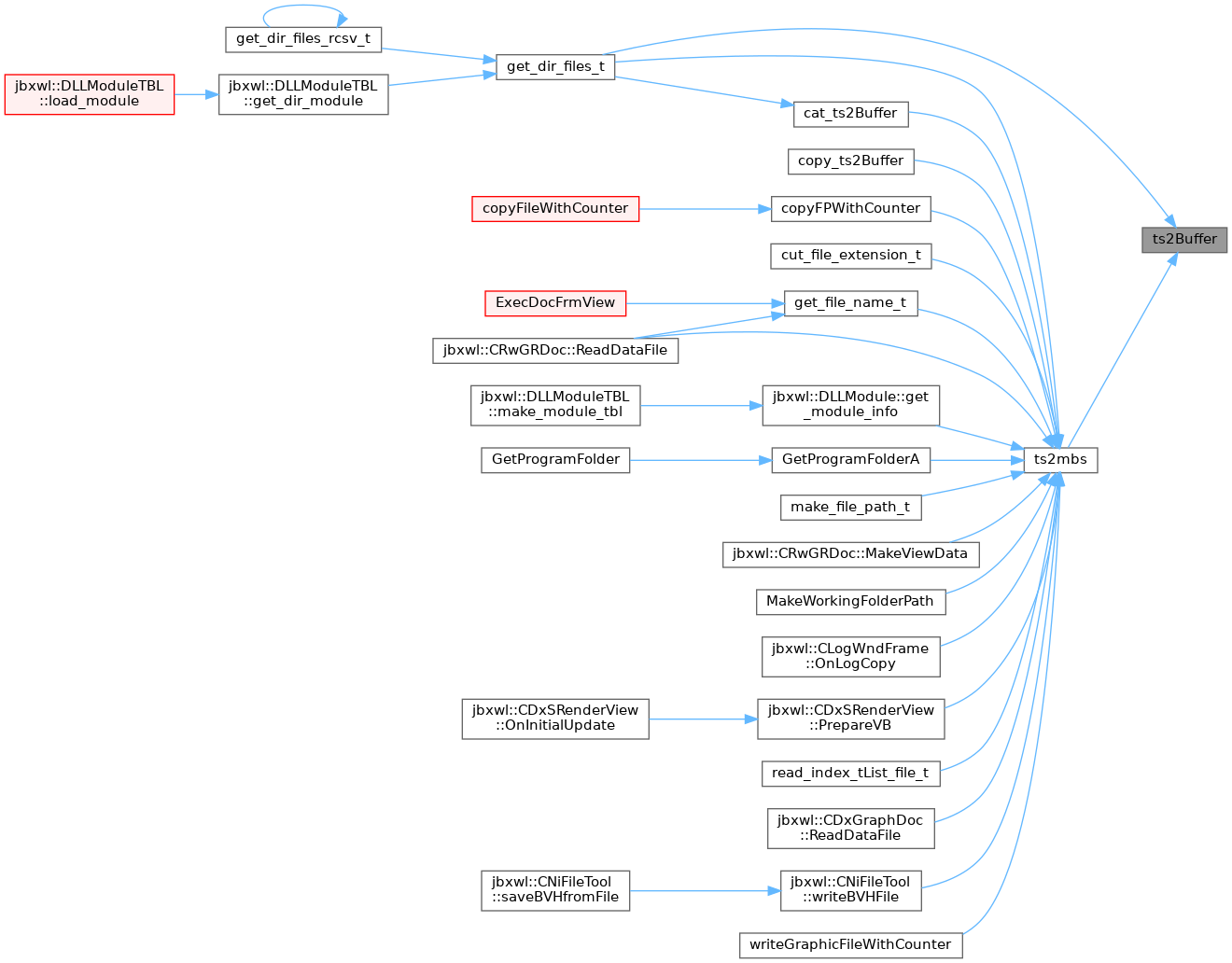
◆ ts2mbs()
|
inline |
Definition at line 57 of file WinTools.h.
References ts2Buffer().
Referenced by cat_ts2Buffer(), copy_ts2Buffer(), copyFPWithCounter(), cut_file_extension_t(), get_dir_files_t(), get_file_name_t(), DLLModule::get_module_info(), GetProgramFolderA(), make_file_path_t(), CRwGRDoc::MakeViewData(), MakeWorkingFolderPath(), CLogWndFrame::OnLogCopy(), CDxSRenderView::PrepareVB(), read_index_tList_file_t(), CDxGraphDoc::ReadDataFile(), CRwGRDoc::ReadDataFile(), CNiFileTool::writeBVHFile(), and writeGraphicFileWithCounter().

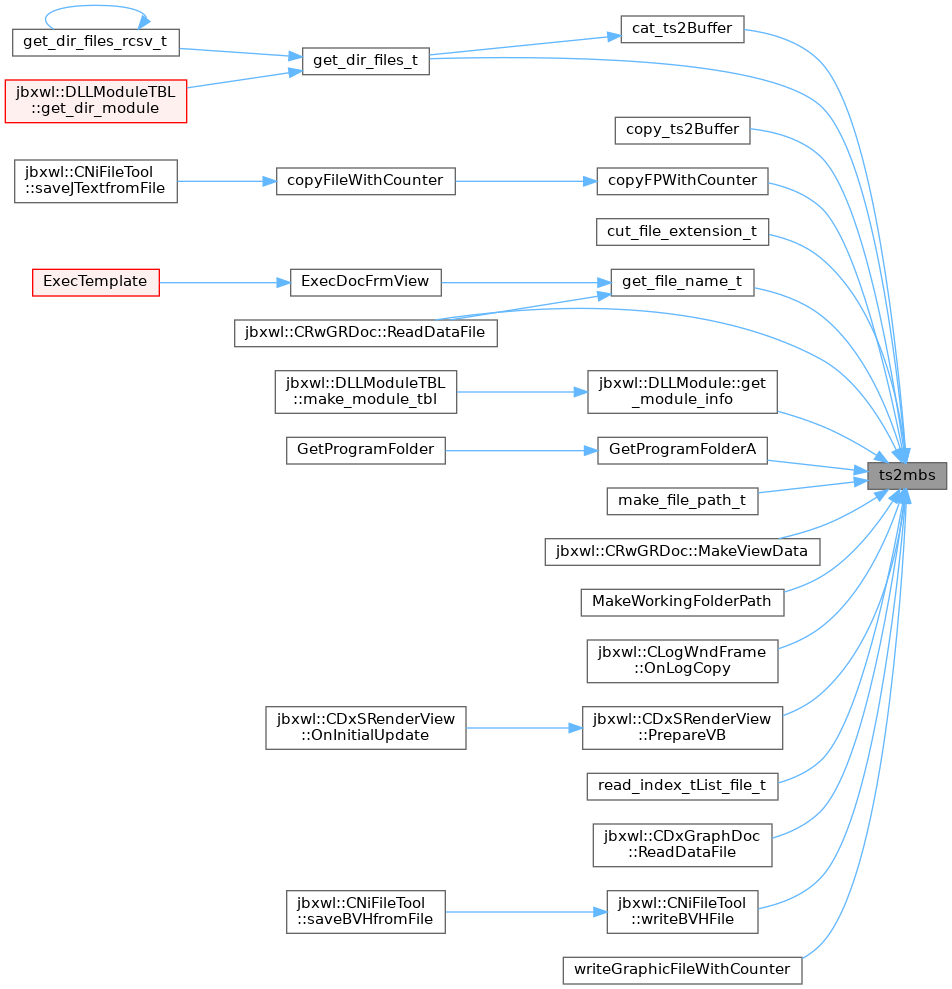
◆ utf8_to_sjis()
| Buffer utf8_to_sjis | ( | void * | ptr, |
| size_t | len ) |
Definition at line 196 of file WinTools.cpp.
Referenced by utf8_to_sjis_byStr().

◆ utf8_to_sjis_byStr()
| Buffer utf8_to_sjis_byStr | ( | CString | str | ) |
Definition at line 185 of file WinTools.cpp.
References utf8_to_sjis().

◆ VMD2NiJointNum()
| int VMD2NiJointNum | ( | int | joint | ) |
VMDのジョイント番号から,共通ジョイントの番号を得る
Definition at line 142 of file NiVMDTool.cpp.
References _VMD2NiJointNum, and VMD_JOINT_NUM.
Referenced by CNiVMDTool::getFramesData().

◆ VMDJointName()
| std::string VMDJointName | ( | int | n | ) |
std::string jbxwl::VMDJointName(int n)
VMDのジョイント番号から,MMDのジョイント名を得る
Definition at line 46 of file NiVMDTool.cpp.
References _VMDJointName, and VMD_JOINT_NUM.
◆ VMDJointNum()
| int VMDJointNum | ( | char * | name | ) |
int jbxwl::VMDJointNum(char* name)
MMDのジョイント名から,VMDのジョイント番号を得る
Definition at line 64 of file NiVMDTool.cpp.
References _VMDJointName, _VMDJointName_eng, and VMD_JOINT_NUM.
Referenced by CNiVMDTool::convert2FrameData().

◆ WaitPidTerm()
| BOOL WaitPidTerm | ( | int | tm | ) |
Definition at line 83 of file MFCTool.cpp.
◆ WinSystem()
| void WinSystem | ( | char * | command, |
| DWORD | flag, | ||
| BOOL | wait ) |
Definition at line 818 of file WinTools.cpp.
◆ writeGraphicFileWithCounter()
| int writeGraphicFileWithCounter | ( | LPCTSTR | fname, |
| MSGraph< sWord > | vp, | ||
| int | kind, | ||
| BOOL | mlt = FALSE, | ||
| int | fn = 0, | ||
| int | tn = 0 ) |
Definition at line 131 of file MFCio.cpp.
References IDD_PROGBAR, IDS_STR_WRTNG_FILE, CProgressBarDLG::Start(), CProgressBarDLG::Stop(), and ts2mbs().

Variable Documentation
◆ _Debug_SHM
|
extern |
Definition at line 103 of file WinSMTool.cpp.
Referenced by close_shm_debuger(), and open_shm_debuger().
◆ Dx9DividePrimitiveMode
|
extern |
Definition at line 20 of file Dx9.cpp.
Referenced by Dx9DrawPrimitive().
◆ Dx9ReverseZMode
|
extern |
Definition at line 21 of file Dx9.cpp.
Referenced by CDxSRenderView::OnInitialUpdate().
◆ GpD3D
|
extern |
Definition at line 13 of file Dx9.cpp.
Referenced by Dx9CreateInterface(), Dx9ReleaseInterface(), and CDxBaseView::InitDevice().
◆ GpDInput
|
extern |
Definition at line 14 of file Dx9.cpp.
Referenced by Dx9CreateInterface(), and Dx9ReleaseInterface().
◆ GpDKeyBoard
|
extern |
Definition at line 17 of file Dx9.cpp.
Referenced by Dx9CreateInterface(), Dx9ReleaseInterface(), and CDxBaseView::InitDevice().
◆ GpDMouse
|
extern |
Definition at line 16 of file Dx9.cpp.
Referenced by Dx9CreateInterface(), Dx9ReleaseInterface(), and CDxBaseView::InitDevice().
◆ SetHeaderDLG
|
extern |
Definition at line 18 of file ReadFilesDLG.cpp.
Referenced by CReadFilesDLG::OnSetHead(), and CRwGRDoc::ReadDataFile().
◆ TimerID
|
extern |
Definition at line 19 of file ExView.cpp.
Referenced by CExView::TimerStart().
◆ WinAudioToolBitsPerSample
|
static |
Definition at line 33 of file WinAudioTool.h.
Referenced by CWinAudioTool::getAudioFormat().
◆ WinAudioToolChannels
|
static |
Definition at line 31 of file WinAudioTool.h.
Referenced by CWinAudioTool::getAudioFormat().
◆ WinAudioToolFormat
|
static |
Definition at line 30 of file WinAudioTool.h.
Referenced by CWinAudioTool::getAudioFormat().
◆ WinAudioToolSamplesPerSec
|
static |
Definition at line 32 of file WinAudioTool.h.
Referenced by CWinAudioTool::getAudioFormat().